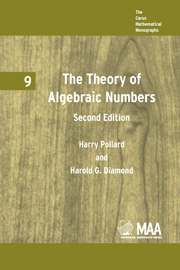Book contents
- Frontmatter
- Dedication
- Contents
- Preface to First Edition
- CHAPTER I Divisibility
- CHAPTER II The Gaussian Primes
- CHAPTER III Polynomials over a field
- CHAPTER IV Algebraic Number Fields
- CHAPTER V Bases
- CHAPTER VI Algebraic Integers and Integral Bases
- CHAPTER VII Arithmetic in Algebraic Number Fields
- CHAPTER VIII The Fundamental Theorem of Ideal Theory
- CHAPTER IX Consequences of the Fundamental Theorem
- CHAPTER X Ideal Classes and Class Numbers
- CHAPTER XI The Fermat Conjecture
- References
- List of Symbols
- Index
CHAPTER X - Ideal Classes and Class Numbers
- Frontmatter
- Dedication
- Contents
- Preface to First Edition
- CHAPTER I Divisibility
- CHAPTER II The Gaussian Primes
- CHAPTER III Polynomials over a field
- CHAPTER IV Algebraic Number Fields
- CHAPTER V Bases
- CHAPTER VI Algebraic Integers and Integral Bases
- CHAPTER VII Arithmetic in Algebraic Number Fields
- CHAPTER VIII The Fundamental Theorem of Ideal Theory
- CHAPTER IX Consequences of the Fundamental Theorem
- CHAPTER X Ideal Classes and Class Numbers
- CHAPTER XI The Fermat Conjecture
- References
- List of Symbols
- Index
Summary
Ideal classes. We are nearly ready to justify the assertion that each ideal in K = R(θ) is the totality of integers in K which are divisible (in the extended sense) by some integer which is not necessarily in K. Our proof will rest on the notion of ideal class.
Two ideals A and B in K are equivalent, written A ∼ B, if there are two non-zero integers α and β in K such that
(α)A = (β)B.
The simplest properties of this equivalence relation are the following:
(i) A∼ A;
(ii) A ∼ B if and only if B ∼ A;
(iii) if A ∼ B and B ∼ C, then A ∼ C;
(iv) all non-zero principal ideals are equivalent.
The totality of ideals in K equivalent to a fixed ideal A ≠ (0) is said to constitute a class. The number of classes (which we shall soon show to be finite) is called the class-number h of K. If the class-number is 1 then all non-zero ideals are equivalent to (1) and so are all principal. From Theorem 9.4 it follows that a field has unique factorization of integers into prime integers if and only if its class-number is 1.
Lemma 10.1. Let A, B, C be ideals in K and A ≠ (0). Then AB ∼ AC if and only if B ∼ C.
- Type
- Chapter
- Information
- The Theory of Algebraic Numbers , pp. 139 - 145Publisher: Mathematical Association of AmericaPrint publication year: 1975



